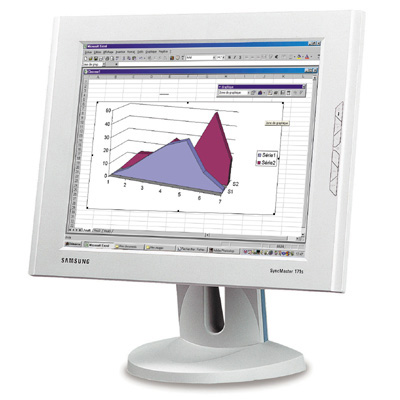
The 181B is Samsung’s upcoming 18”
version of the 171B model. The 181B has a slightly higher pitch of 0.281 and
a viewable angle of 170 degrees. The contrast ratio is 400:1, same as on the
171B. The 181B will be soon available for the public.
A higher contrast ratio results in more defined and in more vibrant color
output. We had these screens running under a dual monitor setup and we can
conclude that the higher contrast ratio on the 171B is barely noticeable under
everyday work such as word processing and internet browsing. The scenario
however changes once we go into the more visual area such as photo editing
under Adobe Photoshop, while not by much, we can tell that the 171B had a
brighter look.
Samsung’s 171S, 171B and 181B are all about style and value. The 171S/B and
181B spots a more integrated and classier design than the previously reviewed
770TFT LCD. The units are only around 65mm thick and contain the power supply
within the main panel, eliminating the need of having an AC adapter lying
around.
The monitor features six control buttons
on the right hand side of the display’s bezel. The
power button is first, fallowing by the menu button used to enter the OSD
menu. The third and fourth buttons are used for brightness adjustments under
a normal operational mode and for browsing the OSD menu. The fifth button
is titled exit fallowing by the sixth which is the auto function, quite a
handy feature that will automatically center the image and adjust the colors
of the monitor.
An interesting feature of these monitors is their Pivot feature. By moving
the stand all the way up, you can rotate the display to a landscape mode.
Samsung bundled Pivot Pro 6.01; a windows application designed to take care
of this rotation task. While I didn’t find any good use for the Pivot feature,
I must say that I found it comfortable for tasks such as office applications
and web browsing. The Pivot Pro software worked flawlessly under my
Windows 2000 PRO setup.
I was quite disappointed to see that
neither of these units features a digital connection (DVI), I would have at
least wanted the more expensive 171B and 181B to offer a digital connection.
While the differences between a digital and analog connection will be minimal
to the average user, the 171B and 181B could have easily made a better impression
featuring one.
Both the 171S and 171B features a maximum resolution of 1280x1024 and a .264
pitch. The 181B features a slightly higher pitch of .281. I was quite pleased
of the image quality of these monitors, under its maximum 1280x1024 resolution
the text was sharp and clear and the image output was bright and high in contrast,
by far superior to what a CRT display can do.
The 171S retails for around 650$ USD while the 171B model can be found around
750$. We have not yet received final pricing for the 181B.
Summation
Samsung has done a nice job on their newest LCD monitors; I would like
to applaud them for their smart and logical design that allowed them to include
the power supply in the same casing as the monitor eliminating the need of
having an AC adapter lying around.
Another point worth mentioning is their handy monitor stand that allows using
the monitor under a vertical (landscape) mode. My major disappointed was the
lack of a digital connection (DVI) on the 171B and 181B, I found this a bit
unfortunate as the monitor would have been a more appealing product for the
high end users if it featured a digital connection.
Overall, I was satisfied with these
three units and wouldn’t have a single problem recommending them for people
looking for a quality LCD at an attractive price. If you are in the market
for a new LCD panel I would recommend taking a look at Samsung’s latest offerings.

171S/171B/181B
Oleg Mitskaniouk
02.02.12
